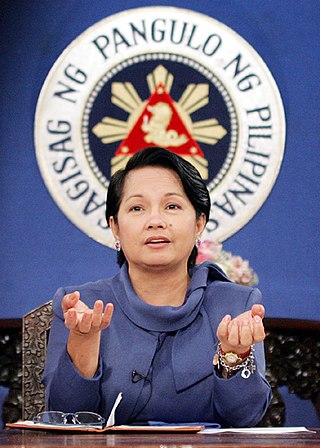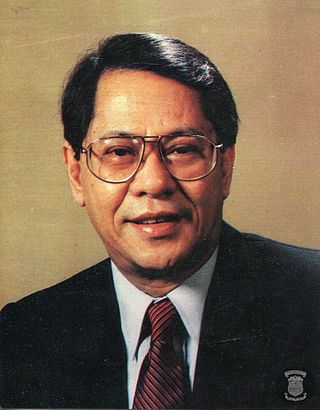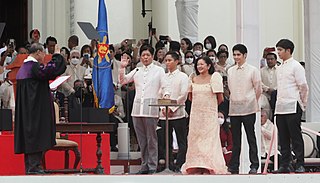
These lists give the provinces of primary affiliation, and of birth for each president of the Philippines, consisting of the 17 heads of state in the history of the Philippines.

These lists give the provinces of primary affiliation, and of birth for each president of the Philippines, consisting of the 17 heads of state in the history of the Philippines.
A list of presidents of the Philippines including the province with which each was primarily affiliated, due to residence, professional career, and electoral history. This is not necessarily the province in which the president was born.
Of the 16 individuals who have served as president of the Philippines, 4 served after officially residing in a different province than the one in which they were born.
| President | Birth province | Home province |
|---|---|---|
| Gloria Macapagal Arroyo | Rizal [4] | Pampanga |
| Benigno Aquino III | Metro Manila [5] | Tarlac |
| Rodrigo Duterte | Leyte [6] | Davao del Sur [3] |
| Bongbong Marcos | Metro Manila [5] | Ilocos Norte |
Presidents with an asterisk (*) did not primarily reside in their respective province of primary affiliation (they were not born in the province listed below).
| Province | Number of presidents | Presidents (#th president of the Philippines) |
|---|---|---|
| Ilocos Norte | 2 | Ferdinand Marcos (10), Bongbong Marcos* (17) |
| Pampanga | 2 | Diosdado Macapagal (9), Gloria Macapagal Arroyo* (14) |
| Tarlac | 2 | Corazon Aquino (11), Benigno Aquino III* (15) |
| Aurora | 1 | Manuel L. Quezon (2) [1] |
| Batangas | 1 | José P. Laurel (3) |
| Bohol | 1 | Carlos P. Garcia (8) |
| Capiz | 1 | Manuel Roxas (5) |
| Cavite | 1 | Emilio Aguinaldo (1) |
| Cebu | 1 | Sergio Osmeña (4) |
| Davao del Sur | 1 | Rodrigo Duterte* (16) [3] |
| Ilocos Sur | 1 | Elpidio Quirino (6) |
| Metro Manila [2] | 1 | Joseph Estrada (13) |
| Pangasinan | 1 | Fidel Ramos (12) |
| Zambales | 1 | Ramon Magsaysay (7) |
A list of birthplaces of presidents of the Philippines. As of February 2024, 13 modern-day provinces, along with the National Capital Region, claim the distinction of being the birthplace of a president.
The number of presidents born per modern-day province are:
Names sort in order of birth Dates sort by month and day | ||||
|---|---|---|---|---|
| President | Date of birth | Birthplace | Province of birth | In office |
| Emilio Aguinaldo [7] | March 22, 1869 | Cavite el Viejo (Aguinaldo Shrine) | Cavite | January 23, 1899 – March 23, 1901 |
| Manuel L. Quezon [8] | August 19, 1878 | Baler | Nueva Ecija [1] | November 15, 1935 – August 1, 1944 |
| Sergio Osmeña [9] | September 9, 1878 | Cebu City | Cebu | August 1, 1944 – May 28, 1946 |
| Elpidio Quirino [10] | November 16, 1890 | Vigan | Ilocos Sur | April 17, 1948 – December 30, 1953 |
| José P. Laurel [11] | March 9, 1891 | Tanauan | Batangas | October 14, 1943 – August 17, 1945 |
| Manuel Roxas [12] | January 1, 1892 | Capiz | Capiz | May 28, 1946 – April 15, 1948 |
| Carlos P. Garcia [13] | November 4, 1896 | Talibon | Bohol | March 18, 1957 – December 30, 1961 |
| Ramon Magsaysay [14] | August 31, 1907 | Iba | Zambales | December 30, 1953 – March 17, 1957 |
| Diosdado Macapagal [15] | September 28, 1910 | Lubao | Pampanga | December 30, 1961 – December 30, 1965 |
| Ferdinand Marcos [16] | September 11, 1917 | Sarrat | Ilocos Norte | December 30, 1965 – February 25, 1986 |
| Fidel Ramos [17] | March 18, 1928 | Lingayen | Pangasinan | June 30, 1992 – June 30, 1998 |
| Corazon Aquino [18] | January 25, 1933 | Paniqui | Tarlac | February 25, 1986 – June 30, 1992 |
| Joseph Estrada [19] | April 19, 1937 | Manila | Metro Manila [5] | June 30, 1998 – January 20, 2001 |
| Rodrigo Duterte [20] | March 28, 1945 | Maasin | Leyte [6] | June 30, 2016 – June 30, 2022 |
| Gloria Macapagal Arroyo [21] | April 5, 1947 | San Juan | Rizal [4] | January 20, 2001 – June 30, 2010 |
| Bongbong Marcos [22] | September 13, 1957 | Manila | Metro Manila [5] | June 30, 2022 – incumbent |
| Benigno Aquino III [23] | February 8, 1960 | Manila | Metro Manila [5] | June 30, 2010 – June 30, 2016 |

Maria Gloria Macaraeg Macapagal, often referred to by her initials PGMA and GMA, is a Filipino academic and politician who previously served as the 14th President of the Philippines from 2001 to 2010. She is the longest serving president of the Philippines since Ferdinand Marcos. Before her accession to the presidency, she served as the 10th Vice President of the Philippines from 1998 to 2001 under President Joseph Ejercito Estrada, making her the country's first female vice president, despite having run on an opposing ticket. She was also a Senator from 1992 to 1998. After her presidency, she was elected as the Representative of Pampanga's 2nd district in 2010 and later became the Speaker of the House of Representatives on 2018 to 2019. She was also serving in the congress as a Deputy Speaker from 2016 to 2017 and from 2022 until her removal in November 2023. She is one of the only 2 Filipinos to hold at least three of the four highest offices in the country: vice president, president, and house speaker, alongside former President Sergio Osmeña.

The president of Republic of the Philippines is the head of state, head of government and chief executive of the Philippines. The president leads the executive branch of the Philippine government and is the commander-in-chief of the Armed Forces of the Philippines.

Malacañang Palace, officially known as Malacañan Palace, is the official residence and principal workplace of the president of the Philippines. It is located in the Manila district of San Miguel, along Jose P. Laurel Street though it is commonly associated with Mendiola Street nearby. The term Malacañang is often used as a metonym for the president, their advisers, and the Office of the President of the Philippines. The sprawling Malacañang Palace complex includes numerous mansions and office buildings designed and built largely in the bahay na bato and neoclassical styles. Among the presidents of the present Fifth Republic, only Gloria Macapagal Arroyo actually lived in the main palace as both her office and her residence, with all others residing in nearby properties that form part of the larger palace complex. The palace has been seized several times as a result of protests starting with the People Power Revolution of 1986, the 1989 coup attempt, the 2001 Manila riots, and the EDSA III riots.

The vice president of Republic of the Philippines is the second-highest official in the executive branch of the Philippine government and is the first in the presidential line of succession. The vice president is directly elected by the citizens of the Philippines and is one of only two nationally elected executive officials, the other being the president.

Edgardo Javier Angara was a Filipino lawyer and politician who served as Senate President from 1993 to 1995. Angara had the second longest tenure in the history of the Senate, serving four terms and a total of twenty-three years. As a legislator, Angara has championed numerous important laws and bills including the free high school law, the Senior Citizen discount law, and many more.

This article covers the history of the current Philippine republican state following the 1986 People Power Revolution, known as the Fifth Philippine Republic.
This list of presidential elections in the Philippines includes election results of both presidential and vice presidential elections since 1899 with the candidates' political party and their corresponding percentage.

The inauguration of the president of the Republic of the Philippines is a ceremony marking the commencement of the six-year term of a president of the Philippines, who is both head of state and head of government. The inauguration is performed on June 30, as mandated by the 1987 Constitution. Under the older 1935 Constitution, the date was December 30, which is also Rizal Day; the last inauguration held on the older date was Ferdinand Marcos' second one on December 30, 1969. The most recent public presidential inauguration ceremony was that of President Bongbong Marcos, who began his six-year term in office on Thursday, June 30, 2022.

The Laban ng Demokratikong Pilipino is a liberal political party in the Philippines.

The secretary of agriculture is the member of the Cabinet of the Philippines in charge of the Department of Agriculture.

The secretary of education is the member of the Cabinet of the Philippines in charge of the Department of Education (DepEd).

The secretary of justice is the head of the Department of Justice and is a member of the president's Cabinet.

Ferdinand Martin Gomez Romualdez is a Filipino businessman, lawyer and politician serving as the Speaker of the House of Representatives since July 25, 2022. He is also serving as the representative for the 1st district of Leyte since 2019 and previously from 2007 to 2016. He formerly served as the House Majority Leader from 2019 to 2022, and unsuccessfully ran for senator in the 2016 elections. He is a first cousin of President Bongbong Marcos. Since May 17, 2023, he has been widely considered to be the country's de facto leader after the ouster of Senior Deputy Speaker Gloria Macapagal Arroyo, becoming the main catalyst to the 2024 Philippine political crisis

Of the seventeen presidents of the Philippines, a number have shown proficiency in languages other than English and Tagalog.

The Cabinet Secretariat, formerly the Office of the Cabinet Secretary, was a member agency of the Cabinet of the Philippines which provided support to the President, facilitated the exchange of information, as well as discussed and resolved issues among Cabinet members. The Cabinet Secretary also acted as a coordinator and integrator of the initiatives of the President. The Cabinet Secretariat was created through Executive Order No. 237, s. 1987.

The Presidential Car Museum is a museum within the Quezon Memorial Circle in Quezon City, Metro Manila, Philippines. The museum displays cars used by the former Philippine Presidents.
The presidential spokesperson was a government official whose primary responsibility was to serve as the speaking representative of the president of the Philippines. The press secretary has historically assumed the role.